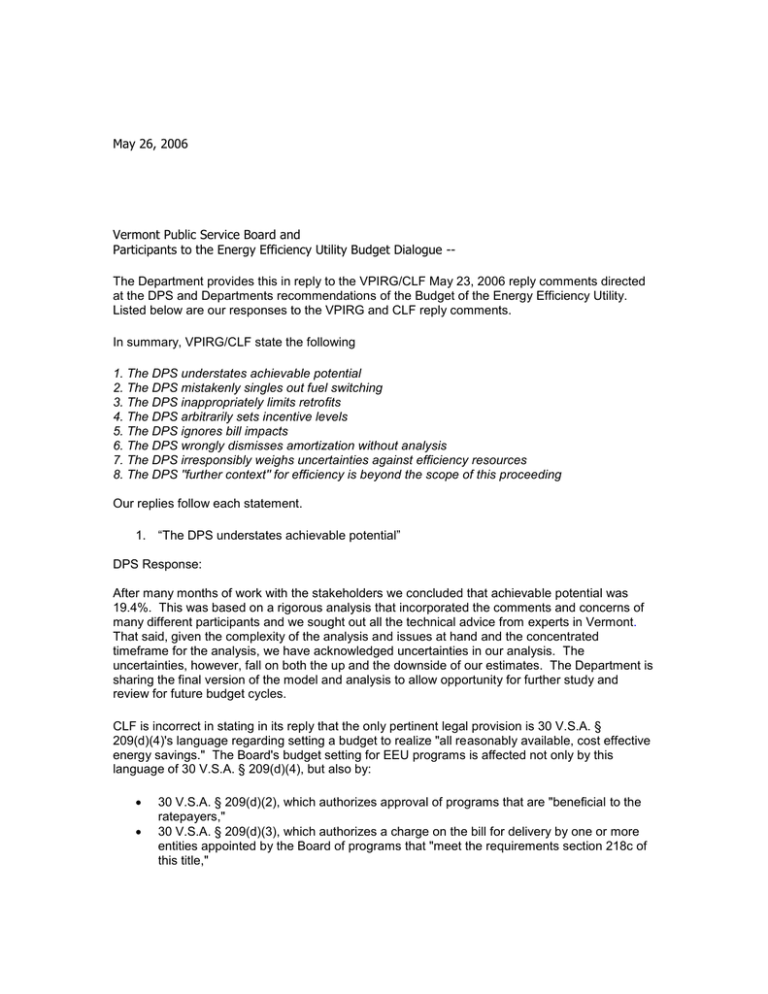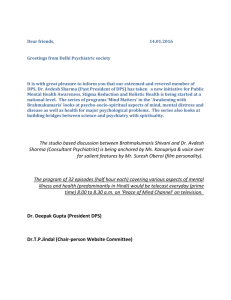May 26, 2006 Vermont Public Service Board and
advertisement

May 26, 2006 Vermont Public Service Board and Participants to the Energy Efficiency Utility Budget Dialogue -The Department provides this in reply to the VPIRG/CLF May 23, 2006 reply comments directed at the DPS and Departments recommendations of the Budget of the Energy Efficiency Utility. Listed below are our responses to the VPIRG and CLF reply comments. In summary, VPIRG/CLF state the following 1. The DPS understates achievable potential 2. The DPS mistakenly singles out fuel switching 3. The DPS inappropriately limits retrofits 4. The DPS arbitrarily sets incentive levels 5. The DPS ignores bill impacts 6. The DPS wrongly dismisses amortization without analysis 7. The DPS irresponsibly weighs uncertainties against efficiency resources 8. The DPS "further context" for efficiency is beyond the scope of this proceeding Our replies follow each statement. 1. “The DPS understates achievable potential” DPS Response: After many months of work with the stakeholders we concluded that achievable potential was 19.4%. This was based on a rigorous analysis that incorporated the comments and concerns of many different participants and we sought out all the technical advice from experts in Vermont. That said, given the complexity of the analysis and issues at hand and the concentrated timeframe for the analysis, we have acknowledged uncertainties in our analysis. The uncertainties, however, fall on both the up and the downside of our estimates. The Department is sharing the final version of the model and analysis to allow opportunity for further study and review for future budget cycles. CLF is incorrect in stating in its reply that the only pertinent legal provision is 30 V.S.A. § 209(d)(4)'s language regarding setting a budget to realize "all reasonably available, cost effective energy savings." The Board's budget setting for EEU programs is affected not only by this language of 30 V.S.A. § 209(d)(4), but also by: 30 V.S.A. § 209(d)(2), which authorizes approval of programs that are "beneficial to the ratepayers," 30 V.S.A. § 209(d)(3), which authorizes a charge on the bill for delivery by one or more entities appointed by the Board of programs that "meet the requirements section 218c of this title," Other language of 30 V.S.A. § 209(d)(4), which requires that the charge be in an amount "that is consistent with the principles of least cost integrated planning as defined in section 218c of this title . . . . " 30 V.S.A. § 209(e), which lists 15 requirements that the Board must follow, including no. 13, which is that the Board must ensure that any energy efficiency program it approves "shall be reasonable and cost-effective." All of the factors that CLF claims are not legal to consider are in fact lawfully considered under one or more of: the requirement of 30 V.S.A. § 209(e)(13) to ensure that programs are "reasonable," the least-cost planning requirements of § 218c, or the requirement that programs be "beneficial to the ratepayers." For example, consideration of “practicality of measures,” “overall fairness,” “promoting a healthy environment for employment,” and “effects on individual ratepayers” are all relevant to the reasonableness of the programs to be funded by the budget. So too is the context in which the programs will be delivered. The Department notes that “bill impacts” is not specifically mentioned in 30 V.S.A. § 209(d). Yet the Department agrees with CLF and VPIRG that bill impacts should be considered in establishing budgets. The Department discusses bill impacts further below. Notwithstanding the legal issues raised by CLF, the DPS recommendations are based on the analysis of achievable potential and our conclusions and recommendations would stand even without further consideration of other factors listed above. 2. “The DPS mistakenly singles out fuel switching” In prior comments VPIRG and CLF highlighted the high oil prices relative to the costs used in the screening. This is a concern that we shared. In light of current market realities it is difficult to ignore its implications for fuel switching and that is simply inappropriate to advance aggressive fuel switching in line with the assessment of achievable potential. Recall that the achievable potential assumed oil prices at a little over $40 a barrel. We are also concerned about the environmental consequences of fuel switching and encourage the Board and others to study this more closely. Our preliminary analysis does not favor fuel switching on environmental grounds and raises considerable concern on economic grounds.1 We acknowledge, however, that case specific application of fuel switching may still be warranted. 3. “The DPS inappropriately limits retrofits” VPIRG and CLF are incorrect. The achievable potential includes retrofits. Retrofits included in the achievable potential analysis for the residential sector include the following: 1 2 3 4 5 1 Residential Retrofit Measures Residential low income program (weatherization, insulation, water heater efficiency measures, etc.) Non low income residential weatherization and insulation program Energy Star windows program Electric space heat fuel conversion Electric water heat fuel conversion Our preliminary analysis suggests that SO2 emissions increase and that while CO2 emissions decrease, the effect of the imminent cap and trade structure may lead to the opposite conclusion for CO2 emissions. That is CO2 remains capped while it is within the electric sector (at least for units 25 MW and above), but is uncapped for other fuels that might be the result of a fuel switch. 6 7 Electric dryer fuel conversion Appliance turn in program for old refrigerators, freezers For the commercial sector they include the following: 1 2 3 4 5 6 7 8 9 10 11 12 13 14 15 16 17 18 19 20 21 Commercial Retrofit Measures VFDs for Milk Transfer Pumps VFDs for Milk Vacuum Pumps EMS install EMS Optimization Programmable Thermostats Retrocommissioning Bi-Level Switching Daylight Dimming Occupancy Sensors Improved Pumping Equipment and Controls Commercial Ice-makers Commercial Reach-In Freezer Commercial Reach-In Refrigerators Door Heater Controls Floating Head Pressure Control Vending Miser for Soft Drink Vending Machines Chiller Tune Up/Diagnostics - 300 ton DX Tune Up/ Advanced Diagnostics Point of Use Water Heater Solar Pool Heating Solar Water Heating System The DPS excluded early retirements, not all retrofits, in our analysis of achievable potential. We did this because (1) early retirements are exceedingly expensive from a budgetary standpoint, (2) are very short lived in terms of the majority of savings, and (3) raise uncertainty about customer response and incentives to levels that differentiate them from more traditional replaceon-burnout and other retrofit programs. We analyzed these as a separate scenario and presented them in appendix G. 4. “The DPS arbitrarily sets incentive levels” The DPS provided an exhaustive explanation of our concerns with reliance on and arbitrary and excessive 100% incentive level that CLF and VPIRG advanced. We have been open in our analysis and our conclusions. We based our assumptions on 50% incentives after considering the best practices and the Departments own experts and experience in Vermont. Detailed program design will require a more detailed assessment and Best Practices warrant paying no more for incentives that circumstances warrant. For our purposes in developing estimates of budgets, some across-the-board assumption was necessary. We based ours on an analysis of other studies, a review of budgets and savings levels, and the National Energy Efficiency Best Practices Study. As we indicated in the report, current EVT incentives vary but are typically well below 50%. A 50% level incentive is a substantial increase in public participation and not a recommendation the DPS made lightly. It is very important to keep in focus the degree of increase that is contemplated in a budget discussion for any public program. 5. “The DPS ignores bill impacts” The point is well taken. Table 1-4 lists total savings (all categories of resources) to the participants, but we did not finish our work on the bill impacts. This is not an oversight, but simply a matter of addressing the issue in relation to the many other demands on the relevant DPS staff. An updated analysis of the rate impact model was shared with the group and the Board in an email on May 24, 2006. Despite our efforts to provide the analysis, there continues to be some controversy around how revenue and bill impacts should be presented. The Department is still discussing the matter with some of those that have been involved and will provide additional updates with forward progress (even if it is after the budget has been set for the last 6 months of this calendar year.) 6. “The DPS wrongly dismisses amortization without analysis” CLF/VPIRG is correct that more analysis is warranted here. For any steady stream of program activity, the amortization of costs will simply shift the initial or early year costs out in time with the resulting higher costs in later periods. We see little point in simply shifting such program costs since the steady state assumption will be at a similar level but at higher costs to future ratepayers. If the Board were to establish an aggressive one-off early retirement program, the Department believes that the Board may need to consider amortization in order to diminish the initial rate impacts. 7. “The DPS irresponsibly weighs uncertainties against efficiency resources” The reference to irresponsible behavior on our part here is unfortunate. The DPS has gone to great lengths in the process to build a strong basis of facts to set the budget. It is important for all sides of the debate to acknowledge all the risks and uncertainties with all resource options in the future. We have raised the issues here to highlight the need to develop better studies and analysis in the future to overcome these uncertainties. It is also important to acknowledge these as uncertainties from our analysis. 8. “The DPS ‘further context’ for efficiency is beyond the scope of this proceeding” The Department is at a loss to understand the CLF/VPIRG objections on both of these latter two issues. The Department's purpose in establishing this further context is simply to help all to consider the broader context with which we believe that Vermont should continue to pursue energy efficiency and provide further context for how we employ the contributions of the Efficiency Utility. The Efficiency Utility is an integral and important part of our efforts to acquire energy efficiency. However, it is not the sole vehicle for delivery energy efficiency. Over time we need to work toward pursuing energy efficiency in the most efficient manner possible and direct programs of the Efficiency Utility in ways that recognize the evolving and dynamic nature of the environment around it. We appreciate this opportunity to further clarify the Department’s analysis, recommendations, and position. Sincerely, J. Riley Allen Planning Director
